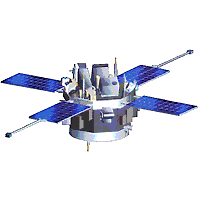ACE Mission
The Earth is constantly bombarded with a stream of accelerated particles arriving not only from the Sun, but also from interstellar and galactic sources. Study of these energetic particles, or cosmic rays, contributes to our understanding of the formation and evolution of the solar system, as well as the astrophysical processes involved. The Advanced Composition Explorer (ACE) spacecraft carries six high-resolution sensors and three monitoring instruments to sample low-energy particles of solar origin and high-energy galactic particles.
 From a vantage point approximately 1/100 of the distance from the Earth to the Sun, ACE performs measurements over a wide range of energy and nuclear mass, under all solar wind flow conditions and during both large and small particle events including solar flares. ACE provides near-real-time solar wind information over short time periods. When reporting space weather, ACE can provide an advance warning (about one hour) of geomagnetic storms that can overload power grids, disrupt communications on Earth, and present a hazard to astronauts.
From a vantage point approximately 1/100 of the distance from the Earth to the Sun, ACE performs measurements over a wide range of energy and nuclear mass, under all solar wind flow conditions and during both large and small particle events including solar flares. ACE provides near-real-time solar wind information over short time periods. When reporting space weather, ACE can provide an advance warning (about one hour) of geomagnetic storms that can overload power grids, disrupt communications on Earth, and present a hazard to astronauts.
ACE launched on a McDonnell-Douglas Delta II 7920 launch vehicle on August 25, 1997 from the Kennedy Space Center in Florida. Ace provides near-real-time 24/7 continuous coverage of solar wind parameters and solar energetic particle intensities (space weather). When reporting space weather ACE provides an advance warning (about one hour) of geomagnetic storms that can overload power grids, disrupt communications on Earth, and present a hazard to astronauts.
ACE orbits the L1 libration point which is a point of Earth-Sun gravitational equilibrium, about 1.5 million km from Earth and 148.5 million km from the Sun. The elliptical orbit affords ACE a prime view of the Sun and the galactic regions beyond. The spacecraft has enough propellant on board to maintain an orbit at L1 until ~2024.



